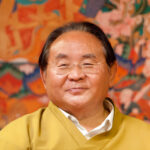Welcome to our thirty fourth online suggested practise for the week. We are now broadcasting a live teaching each Monday evening. If you would like to participate please contact us using the contact form on the homepage.
1.0) If you feel so inclined, begin by reciting the usual prayers (please follow below links for text). Alternatively, try to think or articulate a wish for all beings to achieve liberation from suffering, etc .
Four Thoughts: contemplating each in turn – http://northantsbuddhists.com/the-four-thoughts/
Refuge Prayer: twice in Tibetan, once in English – http://northantsbuddhists.com/the-refuge-prayer/

2.0) The Tibetan Book of Living and Dying by Sogyal Rinpoche – Presented by Geoff Warren

Bardos & Other Realities
Bardo is a Tibetan word that simply means a “transition” or a gap between the completion of one situation & the onset of another. Bar means “in between” & do means “suspended” or “thrown”. Bardo is a word made famous by the popularity of the Tibetan Book of the Dead. Since its first translation into English in 1927, this book has aroused enormous interest among psychologists, writers & philosophers in the West & has sold millions of copies.
The title Tibetan Book of the Dead was coined by its translator, the American scholar W.Y. Evans-Wentz, in imitation of the famous (& equally mistitled) Egyptian Book of the Dead. The actual name of the book is Bardo Todrol Chenmo, which means “the Great Liberation through Hearing in the Bardo”. Bardo teachings are extremely ancient & are found in what are called Dzogchen Tantras. These teachings have a lineage stretching back beyond human masters to the Primordial Buddha (called in Sanskrit Samantabhadra & in Tibetan Kuntuzangpo), who represents the absolute, naked, sky-like primordial purity of the nature of our mind. But the Bardo Todrol Chenmo itself is part of one large cycle of teachings handed down by the master Padmasambhava & revealed in the 14th Century by the Tibetan visionary Karma Lingpa.
The Great Liberation through Hearing in the Bardo, the Tibetan Book of the Dead, is a unique book of knowledge. It is a kind of guidebook or a travelogue of the after death states, which is designed to be read by a master or spiritual friend to a person as the person dies & after death. In Tibet there are said to be “5 methods for attaining Enlightenment without Meditation” : on seeing a great master or sacred object, on wearing specially blessed drawings of mandalas with sacred mantras; on tasting sacred nectars, consecrated by masters through special intensive practice, on remembering the transference of consciousness, the phowa , at the moment of death; & on hearing certain profound teachings, such as the Great Liberation through Hearing in the Bardo.
The Tibetan Book of the Dead is destined for a practitioner or someone who is familiar with its teachings. For a modern reader it is extremely difficult to penetrate & raises a lot of questions that simply cannot be answered without some knowledge of the tradition that gave birth to it. This is especially the case since the book cannot be fully understood & used without knowing the unwritten oral instructions that a master transmits to a disciple & which are the key to its practice.
In this book, then, I am setting the teachings, which the West has become familiar with through the Tibetan Book of the Dead, in a very much larger & more comprehensive context.
Bardos
Because of the popularity of the Tibetan Book of the Dead, people usually associate the word bardo with death. It is true that “bardo” is used in everyday speech among Tibetans for the intermediate state between death & rebirth, but it has a much deeper & wider meaning. It is in the bardo teachings, perhaps more than anywhere else, that we can see just how profound & all-encompassing the buddhas’ knowledge of life & death is, & how inseparable what we have called “life” & what we have called “death” truly are, when seen & understood clearly from the perspective of enlightenment.
We can divide the whole of our existence into 4 realities: life, dying & death, after death & rebirth. These are the 4 bardos:
- The “natural bardo of this life
- The “painfull” bardo of dying
- The “luminous” bardo of dharmata
- The “karmic” bardo of becoming
1. The “natural bardo of this life spans the entire period between life & death. In our present state of knowledge, this may seem more than just a bardo, a transition. But if we think about it, it will become clear that, compared to the enormous length & duration of our karmic history, the time we spend in this life is relatively short. The teachings tell us emphatically that the bardo of this life is the only & therefore the best time to prepare for death: by becoming familiar with the teaching & stabilising practice.
2. The “painfull” bardo of dying lasts from the beginning of the process of dying right up to the end of what is known as the “inner respiration”; this, in turn culminates in the dawning of the nature of mind, what is called the “ground luminosity”, at the moment of death.
3. The “luminous” bardo of dharmata encompasses the after-death experience of the nature of mind, the luminosity or “clear light” , which manifests as sound, colour & light.
4. The “luminous” bardo of dharmata or becoming is what we generally call the Bardo or intermediate state, which lasts right up until the moment we take a new birth.
What distinguishes & defines each of the bardos is that they are all gaps or periods in which the possibility of awakening is particularly present. Opportunities for liberation are occurring continuously & uninterruptedly throughout life & death & the bardo teachings are the key or tool that enables us to discover & recognise them & to make the fullest use of them.
—–0——
